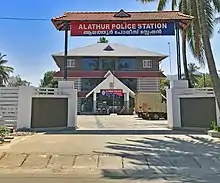Police station
A police station (sometimes called a "station house" or just "house") is a building which serves to accommodate police officers and other members of police staff. Police stations typically contain offices and accommodation for personnel and vehicles, along with locker rooms, temporary holding cells and interview/interrogation rooms.
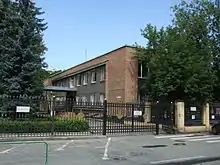
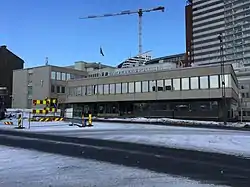
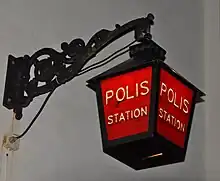
Names
Large departments may have many stations to cover the area they serve. The names used for these facilities include:
- Barracks for many American state police and highway patrol stations and in Ireland
- District office, typically used by American state police forces like the California Highway Patrol, but also used by smaller departments like the Calgary Police Service
- Precinct house, or precinct, for some urban police departments in the United States such as the New York City Police Department, Memphis Police Department, and Newark Police Department, where stations are in charge of precincts
- Police house
- Police office, especially in Scotland
- Station house
- Substations, smaller stations used by many departments, especially county sheriffs
- Detachment, most notably used by the Royal Canadian Mounted Police
- Thana, used in the Indian subcontinent
Multiple informal names exist, such as "cop shop", "cophouse" or (in the UK) "nick".
The area a police station serves has a variety of different names, such as precinct, district, division and zone. However, in some police forces such as Hampshire Constabulary, police stations do not serve a specific area and the officers have great flexibility over where they can operate.
Facilities
Typical facilities at police stations typically include:
- Office space where officers, detectives and administrative staff can work
- Cells for detainees. In the UK, the area with cells is known as a custody suite
- Interview rooms for both detainees and non-detained visitors
- Evidence rooms for storing evidence and seized property
- Lockers and storerooms for storing equipment
- A reception desk for public visitors
- Car park for fleet vehicles and officer-owned personal vehicles
- A room for personnel from other emergency services
Specialized stations exist in a number of countries, typically containing more or less of these facilities. An example includes women's police stations in Latin America.
By country
Greece
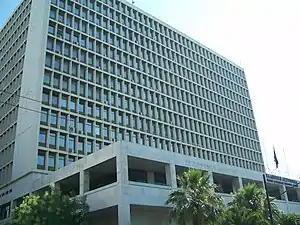
There are 1,024 police stations and directorates in the Greek territory, each of them is responsible for the safety of the citizens in their area. They usually have parking areas for vehicles, interrogation areas and holding cells.
India
In India, police stations are referred to as 'Thana' or 'Thane'. The term "thana" is derived from the Persian word "sthan," which means a place or location. The British colonial administration adopted this term, and it has been widely used ever since. There are regional variations, such as "Kāval nilaiyam" in Tamil Nadu, etc. Police stations have a designated area under their jurisdiction. Police stations are headed by a station house officer (SHO) who may be of inspector or sub-inspector rank, assisted by an assistant sub-inspector, head constables, and constables. The number of personnel in a particular police station depend on many factors like area covered, population, topography, crime rate, sensitivity, important places and others. Some police stations may have police outposts under them. Police outposts are set up when areas covered by police stations have difficult topography, a lack of transportation, high population density, communally sensitive places and border points, or if the area is very large.[1] There are many police stations in India which lack basic infrastructure like proper buildings, landline telephones, wireless sets, vehicles, computers and adequate police personnel.[2][3] Specialized police stations also exist for specific purposes, such as cyber crime, railway, traffic enforcement, women, and others.
Ireland
The police stations (or barracks) of the Garda Síochána come in the following types, in ascending order of size:
- Sub-district stations: Stations in small towns and villages, led by an officer who is no higher in rank than a sergeant. Since the 1980s, many of these small stations have been closed or reduced to operating part-time.
- District headquarters: Located in the largest town in a Garda district, with the most senior officer being a superintendent.
- Divisional headquarters: Located in the largest town or city within a Garda division, which in turn comprises multiple districts. The most senior officer is a chief superintendent.
- Garda headquarters: Located in Phoenix Park, Dublin and includes the office of the Garda Commissioner, as well as other senior officers.
Iran
FARAJA police command established in 2022 replaced NAJA police force has provincial and county commands, Police electronic offices are called Police +10 (پلیس+۱۰). Iranian cities needs 2000 more police stations/bases per deputy command.[4] There are four thousand patrols.[5]
United Kingdom
The county constabularies in Great Britain were previously organised on a village basis. Most villages of any size had a "police house". Police houses in small villages were often staffed by a single uniformed constable, with larger stations being staffed by more. Local police stations were grouped together under the command of a uniformed sergeant, whose station was known as a "sergeant's station". Larger towns in the county constabulary areas had police stations staffed by a number of officers, often under the command of an inspector or superintendent, usually also commanding a sub-division or division respectively, and therefore giving the names of "sub-divisional station" or "divisional station" to their stations.
In Scotland a police station may be referred to as a police office.
United Arab Emirates
As well as traditional, staffed, police stations, there are a number of kiosks in Dubai allowing instant access to police services via a video touchscreen.
Image gallery
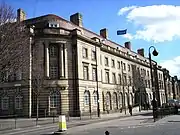 An English police station: Wood Street station in Wakefield
An English police station: Wood Street station in Wakefield Police Assistance Booth, Manali, Himachal Pradesh, India
Police Assistance Booth, Manali, Himachal Pradesh, India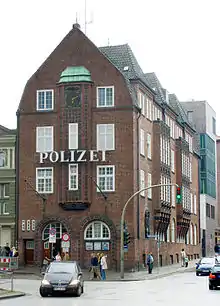

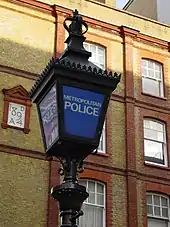 Many British and Commonwealth police stations have a blue lamp outside
Many British and Commonwealth police stations have a blue lamp outside Cells used in Leith Police Station between 1833 and 2003
Cells used in Leith Police Station between 1833 and 2003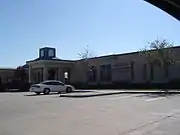 J.C. "Buster" Court Public Safety complex in Stafford, Texas
J.C. "Buster" Court Public Safety complex in Stafford, Texas%252C_Patagonia%252C_Cerro_Castillo%252C_police_station_and_fire_truck.JPG.webp) Police station in Patagonia (southern Chile)
Police station in Patagonia (southern Chile)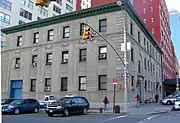
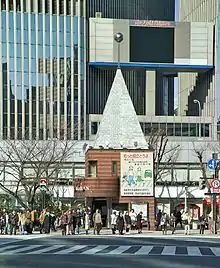
See also
- Police
- Law enforcement
- Law enforcement agency
- List of police stations, about notable individual stations
- Custody suite
- Dubai Smart Police Stations
- State police
References
- "Police Reforms in India". Retrieved 10 March 2021.
- "Are police stations in India equipped with basic infrastructure and adequate staff?". The Hindu. 4 December 2019. Retrieved 10 March 2021.
- "Revision of Standards for Modern Police Station Buildings" (PDF). Archived (PDF) from the original on 31 October 2017. Retrieved 10 March 2021.
- "کمبود ۲ هزار کلانتری و پاسگاه در کشور". خبرگزاری مهر | اخبار ایران و جهان | Mehr News Agency (in Persian). 2022-06-12. Retrieved 2023-07-08.
- "کشف جرم سریع؛ دلیل اعزام فوری ماموران مرکز فوریتهای پلیس". خبرگزاری مهر | اخبار ایران و جهان | Mehr News Agency (in Persian). 2022-06-20. Retrieved 2023-07-08.
